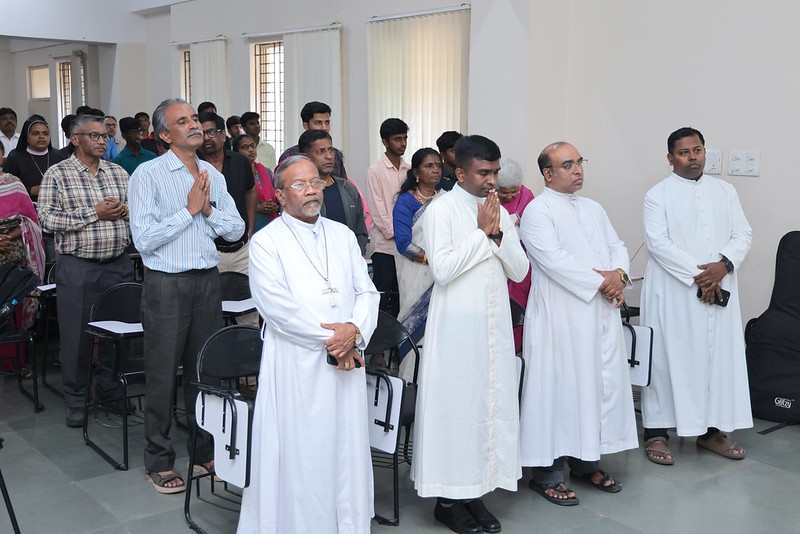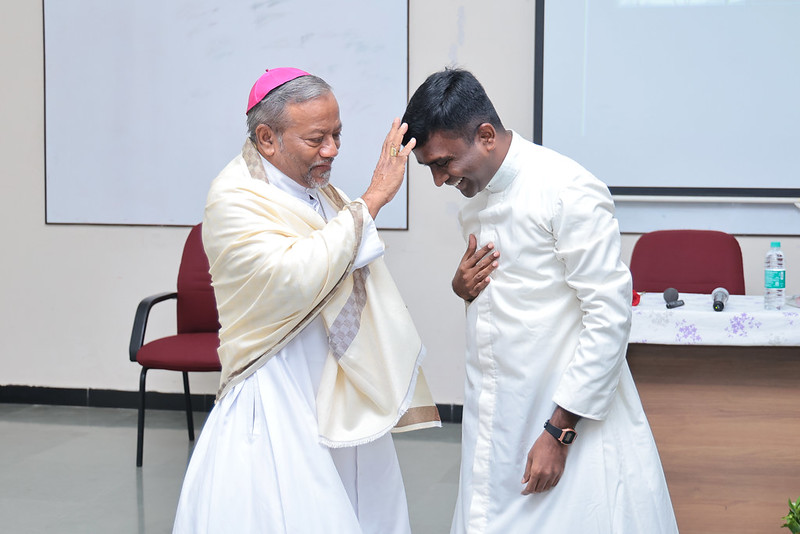At the V National Conference of the CCBI Commission for Women, reflecting on the theme "Pilgrims of Hope for a Synodal Journey," Rev. Dr. Yesu Karunanidhi, the National Coordinator for the Jubilee 2025, presented on "Jubilee 2025: Meaning, Purpose, Preparation, and Participation."The presentation was attended by 72 committed women leaders who work at the Parish, Diocesan, Regional level Commissions for Women.
Most Rev. Dr. Kishor Kumar Kujur, Chairman of the CCBI Commission for Women, presided over the Conference. The event was organised by Sr. Lidwin Fernandes UFS, Executive Secretary to the Commission, and a Member of the National Consultative Team for Jubilee 2025.
The participants were trained on integrating Synod for a Synodal Church, and Jubilee 2025 into their ministry.
The women took a pledge that they would revisit the treasures of the Second Vatican Council, and would dedicates themselves in prayer.
The outline of the presentation is as follows:
1. Women and Women’s Ministry
a. The first woman in the Bible (cf. Gen 2:22-23): Isha. The first mother in the Bible (cf. Gen 3:20): Havvah (Eve).
b. The woman becomes a mother through three movements: (a) Movement to the Tree (encountering the evil; quest for truth); (b) Movement to the Man (co-responsibility); and (c) Movement to God (resilience).
c. Ministry to women at the National-Regional-Diocesan-Parish levels involves the aforesaid three movements: (a) Movement to the People (cf. Tree); (b) Movement towards other Commissions; and (c) Movement towards God. Remember these two principles (cf. Pope: Laudate Deum, n. 19): (a) Everything is interconnected; (b) No one makes it alone.
2. Jubilee 2025: Meaning – Purpose – Preparation – Participation
a. Jubilee in the Bible: ‘yobel’ (= ram’s horn) – 50th year (7x7) – four R’s: rest, review, restore, reconcile (Lev 25:8-13); year of Lord’s favour (Isa 61) – past (liberation), present (consolation), future (moving forward).
b. Jubilees in history: First Ordinary Jubilee year in 1300 by Boniface VIII. Jubilee 2000. Extraordinary Jubilee of Mercy in 2015.
c. Jubilee 2025. Motto and Logo: Pilgrims of Hope. Four figures. Solidarity. Cross. Anchor. Collective.
d. Characteristics of the Jubilee: (i) Pilgrimage (journey, crossing of boundaries, going across the fields, with other journeying companions); (ii) Holy Door (powerful sign, four Roman Basilicas, Jesus is the Door, journey to the interior of a church); (iii) Reconciliation (placing God at the centre of our lives, restoration of social justice, confession); (iv) Prayer (being open to God’s presence and his offer of love); (v) Liturgy (public prayer of the Church, summit and font, opening of the door); (vi) Profession of faith (identity of the baptized person, Apostolic Creed, Nicene Creed); and (vii) Indulgences (experience of God’s mercy, offering up sufferings).
e. Purpose of the Jubilee: (i) To celebrate Jesus. (ii) To celebrate the Church. (iii) To celebrate us.
f. Two Years of Preparation: (i) 2023 as Year of the Council (Year of Learning); (ii) 2024 as Year of Prayer. The Holy Father wishes that the four Constitutions of the Second Vatican Council be studied to obtain direction and guidance for God’s people: Bible (Dei Verbum), Liturgy (Sacrosanctum Concilium), Church (Lumen Gentium), World (Gaudium et Spes). One Year of Celebration: 2025. Enter the Holy Doors of the four Major Basilicas; We may also enter the doors for hope, lighting a ray of hope in prisons, homes for the elderly and the dying destitute, hospitals, and refugee camps.
3. Integrating Women’s Ministry with Synod & Jubilee 2025
a. Ministry to (recipients) / for (beneficiaries) / through (instruments) / with (collaborators) women.
b. Identifying the challenges (internal) and the obstacles (external).
c. Ideas: (i) Create Synod-Jubilee 2025 consciousness (logo, symbols, flags, colours); (ii) Choose synod (communion-mission-participation), jubilee 2025 (Bible, Liturgy, Church, World) as your themes for reflection; (iii) Prayer rally or prayer service; (iv) Visits to the prisons, hospitals, refugee camps, old age homes, orphanages, and other where people need hope; (v) Visits to the shrines and the basilicas; and (vi) Reflect on the Diocesan Synthesis and identify areas of enhancement.
d. Paths: (i) Women, not as followers, but as partners; (ii) Give them what they need, not what you have; (iii) Believe in magic, not logic; (iv) Anything that you invest your time grows; (v) Make it personal – one to one; and (vi) Create support groups.
















